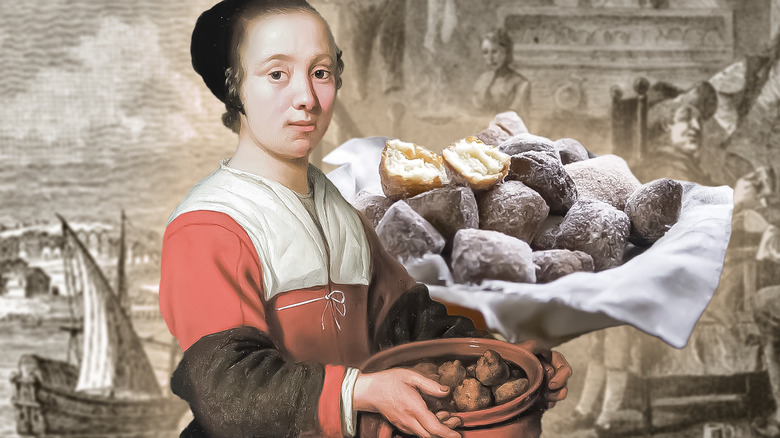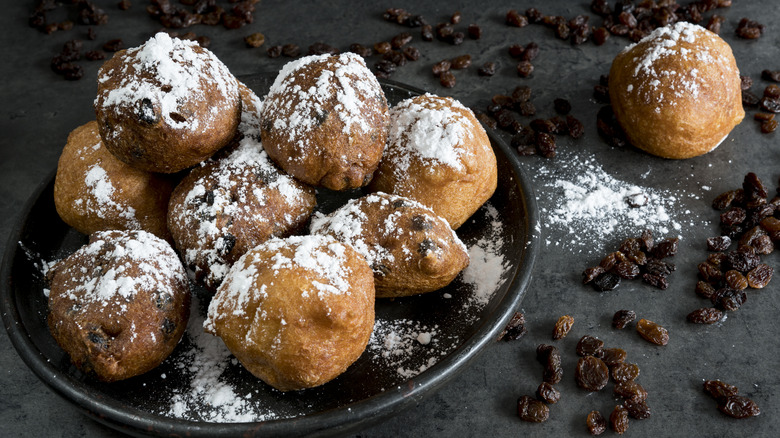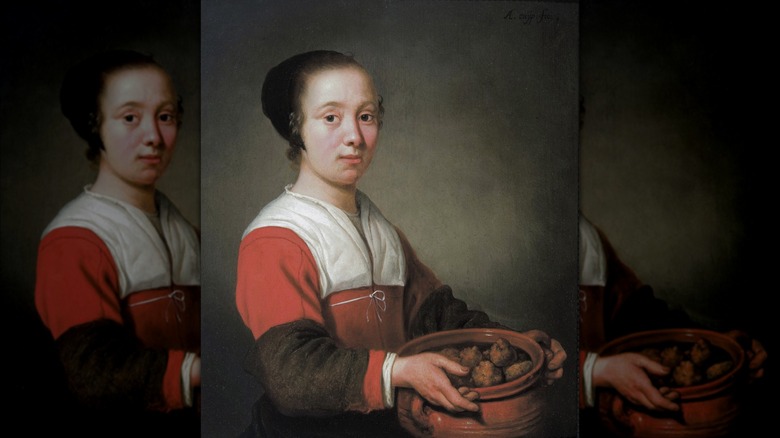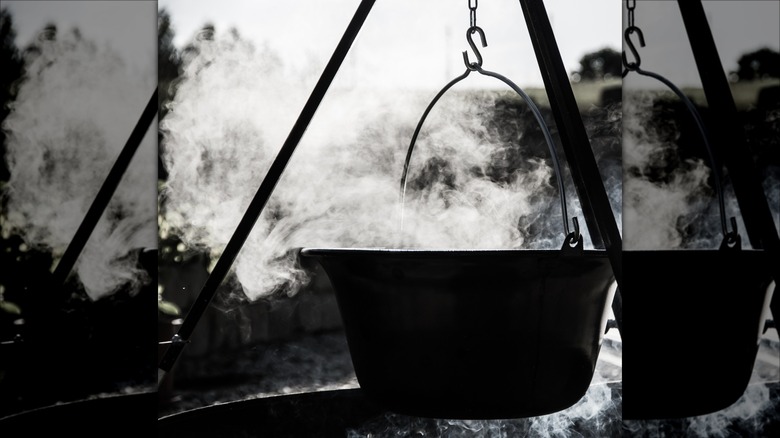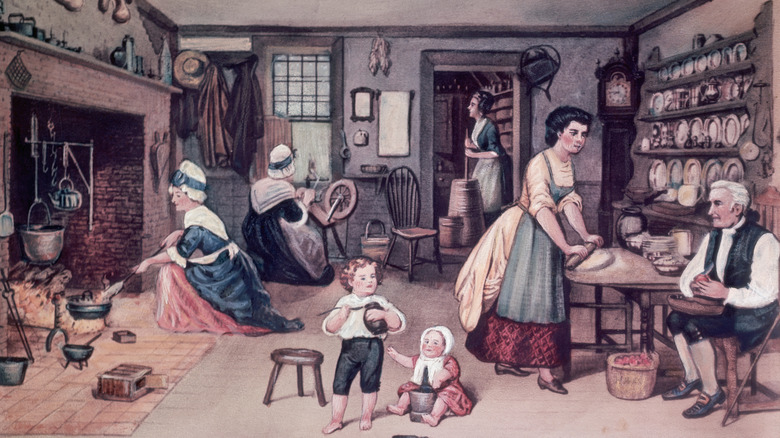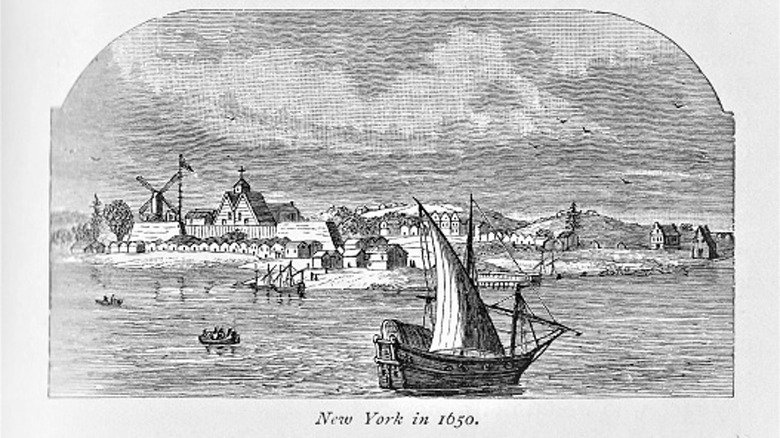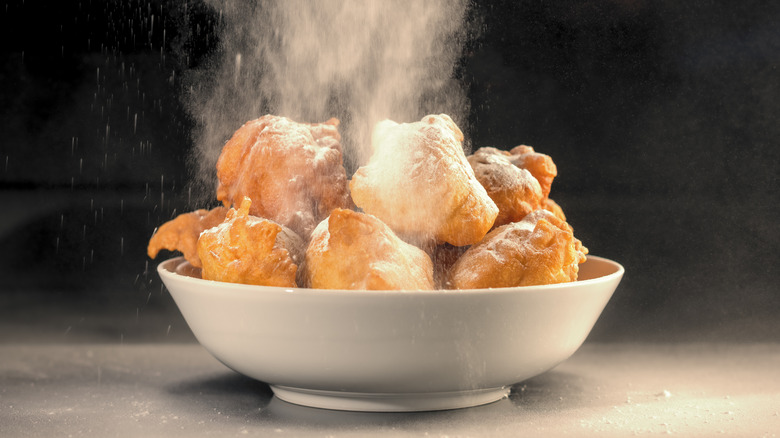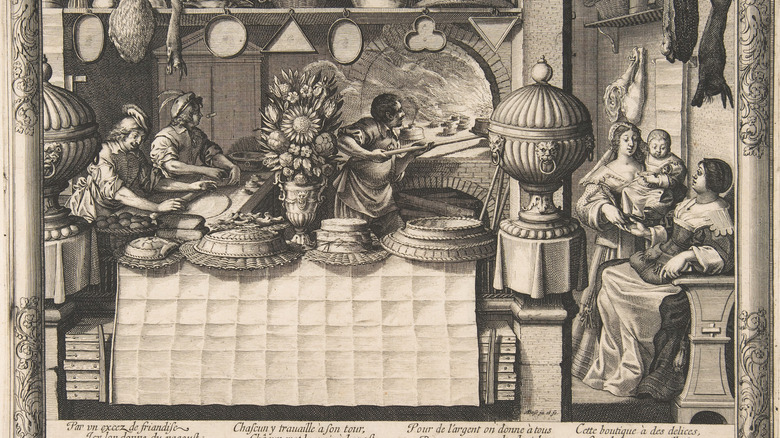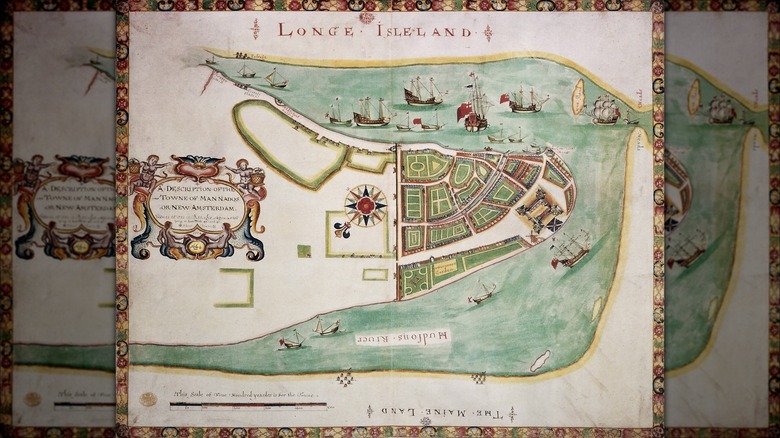What It Was Like To Eat At America's First Donut Shop In 1673
It's hard to imagine an America without donuts. From donut dynasties like Dunkin and Krispy Kreme, to pop culture staples like the signature Simpsons pink donut, donuts are all around American culture. You may be surprised to learn that the first donut shop in America dates back to the 1600s, before the colonies were even a united country.
The first donut shop was founded by Anna Joralemon in New York City. Joralemon set up shop on Maiden Lane off Broadway, where she sold "olykoeks," pronounced similarly to "oily cakes." This was in the days before the title "donut" even existed. But as Shakespeare said, a donut by any other name would taste as sweet. (Or something to that effect.)
Sadly, this donut shop is no longer open, and even more sadly, we don't know much about it other than the location. That said, we can look back at history to figure out what it would have been like to get these early donuts and what an early donut shop would have been like.
What the original donut looked and tasted like
One thing that might surprise people is the lack of holes in the original donut recipe. Donuts did not receive the signature "O" shape until much later. It is believed that the hole in the donut came about in the mid-1800s as a way to help donuts cook more evenly and avoid an overcooked edge, with a doughy, undercooked center.
Back in 1673, donuts would have been formed into rough-shaped flattened dough balls, before being fried to a perfect golden brown. They would have puffed up and rounded out.
These early donuts would have been made with a yeasted dough, similar to the dough we have today, but instead of being topped with Oreos or colorful frostings, they would have been packed with crushed nuts and dried fruits. These are items that would have lasted well beyond fresh fruits and provided a sweet touch. One difference between traditional olykoeks and the Americanized versions was the inclusion of sweeteners. We know that by the 1800s American recipes included cane sugar, which was not included in early Dutch recipes.
Finally, the donuts would have likely been fried in lard. Today we tend to use vegetable oil, as it is cheap and easily accessible, but back in the colonial era, lard was the common fat used for frying. Lard would add a distinct crisp and nuanced flavor that you do not get from vegetable oil, for better or worse.
Inspiration for the original recipe
Many cultures all over the world have a recipe for fried dough, and why wouldn't they? Fried dough is delicious. What became the modern-day donut, though, is based on the Dutch olykoek, which means "oily cake." It is likely to have come from either Holland or the Netherlands by way of early colonists from those countries. The earliest surviving recipe for these early donuts comes from a 1667 Dutch cookbook — "De Verstandige Kock," which translates to "The Sensible Cook." It is possible this recipe, or one that's similar, became the inspiration for Joralemon's donuts.
The origins of Dutch donuts go back even further, though, as a 1652 Dutch painting illustrated a maiden holding a bowl filled with round fried donuts. Joralemon likely took inspiration from this traditional Dutch treat when she set up shop in what is now New York.
Fried dough balls have gone on to become an integral part of Dutch New Year celebrations, where a treat called "oliebollen" are made as part of the celebration.
How they would have cooked
We love deep-fried foods here in the United States, which may be thanks, in part, to those early Dutch colonists. The Dutch didn't just bring donuts; they helped popularize deep-fried foods here. Today, we have deep fryers and automatic donut cutters, but these luxuries were not available to the early colonists. Donuts would have been made, appropriately, in a Dutch oven. A Dutch oven is a heavy cast iron pot. This would have been hung over an open flame in a stone fireplace. As discussed, colonists likely would have used lard, though translated Dutch recipes from that period used rapeseed oil.
The dough would have been mixed by hand or with a wooden spoon. Balls would be scooped out, and the dough would be left to rise. When ready, the dough would be dropped into the hot fat to dry, turning until the dough was cooked, then removed with a slotted spoon. Due to a lack of temperature control, it would be easy to overcook the outside while undercooking the interior of the donut. This is what eventually led to the design of the donut we have today, featuring a hole in the middle. It would take skill and practice to learn how to cook these early donuts perfectly.
What the interior would be like
What would the inside of Anna Joralemon's donut shop be like? Hot! There would be a prominent brick and stone stove that would offer an open flame with a Dutch oven hanging on it. This is where it would differ from, say, a traditional bake shop, which would prominently feature a large oven at the time. However, both would have functioned as the heat center of the building. During the summer, this could be torturous, but during the winter, it would be a warm place to stop for a quick bite.
However, it is important to note that people would likely not be stopping in to eat in the shops. Bakery shops were often packed with tools hanging from ceilings and walls, which did not always make them inviting. Bakery shops at that time tended to be stores where you stopped in and purchased items to take home with you; it is likely this donut shop would have functioned in much the same way. There would not have been much extra room for moving around. Art showing bakeries and pastry shops of that time show small spaces, mostly comprised of the cooking area.
What the exterior would have looked like
When you think of New York City, most people think of big buildings, concrete roads, and industrial scenery as far as the eye can see. This was not the case in 1600s New York (known then as New Amsterdam). Instead the area was still a port city, with large swaths of green, and relatively short buildings. Buildings would have been only a few stories tall, much different than the Manhattan we think of today.
Drawings of the time show one- and two-story buildings spaced decently apart. The roads would have been unpaved and dusty or muddy. The exterior would have been simple stone construction with window cutouts. No bright neon sign would have adorned the outside. Instead, a carved and painted wooden sign likely would have indicated to people what the shop was and what it sold. Examples of signs from around the time show how simple and beautiful these signs could be.
How donuts were served
Anna Joralemon's shop likely wouldn't have seen customers eating right then and there. Instead, people would have taken out her sweets to be eaten as a snack or possibly eaten on the go.
If served at home, these treats could be served as part of teatime. They could also be served as part of a larger meal. In Washington Irving's famous 1820s story "The Legend of Sleepy Hollow," Irving describes a luxurious feast that includes "oly koek" and even names them as "doughnut."
Early colonists may have used wooden plates for serving. The donuts could have been served plain, or with sugar on top. While original Dutch recipes did not contain sugar at the time, early American recipes were likely adapted to use this additional sweetener — including a recipe for donuts in "The Art of Cookery Made Plain and Easy" by Hanna Glasse, which was published in 1805.
The cost of a donut
Since we don't have any donut shop price lists from that time, we have taken a look at other sources to try to understand what a donut from Anna Joralemon's shop would have cost. To do this, we looked at what bakeries would have charged for biscuits at the time.
The first problem we encounter is that the United States did not exist yet. There were colonies from different parts of the world, and each group of colonists brought their own money. Spanish and French coins found their way into circulation at points. England banned the colonies from creating their own currency; however, in 1652, Massachusetts minted its own coins anyway. There was also paper money used, but this did not catch on well due to inflation issues. Despite these issues, people did have to pay for things somehow, which at times meant bartering.
That said, for certain baked items, there was legislation that stipulated their size and price. For example, in Massachusetts in 1640, a loaf of white bread had to be 12 ounces and would cost $0.02. It's then easy to see why donuts would have been cheap. In 1773, roughly 100 years after the first donut shop, a single biscuit would cost the equivalent of $0.009. Donuts would have been a cheap and accessible sweet treat for the colonists.
What New York was like at the time
Early America was a tumultuous place in a tumultuous time. The same year that Anna Joralemon opened her donut shop, the Dutch took over what is now New York City.
In 1662 and 1663, a fleet from The Netherlands seized control of New York and renamed the captured area New Amsterdam. Its claim lasted only a year, however, before the English regained control of the area and it became New York. During this time, though, many of the Dutch people stayed and the world did not stop. Dutch culture was taking hold and cultural items such as donuts were taking hold in the community. While the Netherlands' government was not able to keep control of the area for long, the lasting impact the Dutch colonial community made is still felt today.
Ultimately, New York was a bustling place where things were changing rapidly. Governments were still trying to figure out what to do with this area, who should run it, and how. Despite this, business owners had to keep making a living and the people of New York still needed to eat.
The lasting impact
While Anna Joralemon's shop is no longer around today, America still loves donuts. Her work helped lay the groundwork for companies such as Dunkin to take hold and win over the American public across many years and through many demographic changes.
It is not just that Americans love fried dough, which is undeniably delicious. It is that, as we've seen since the beginning, donuts were used as a cheap little treat that one could pick up easily. This has carried on in American tradition. During the Depression, donuts were given out to those arriving at Ellis Island.
During both World Wars, American soldiers were given donuts to help fuel them and give them a treat. Donuts in America aren't just donuts; they are a symbol of ingenuity and finding a way to make something delicious for everyone. Anna Joralemon helped create the donut as an American symbol when America was still trying to figure out what it was going to be. Now, hundreds of years later, we see the lasting impact her contribution has made.
